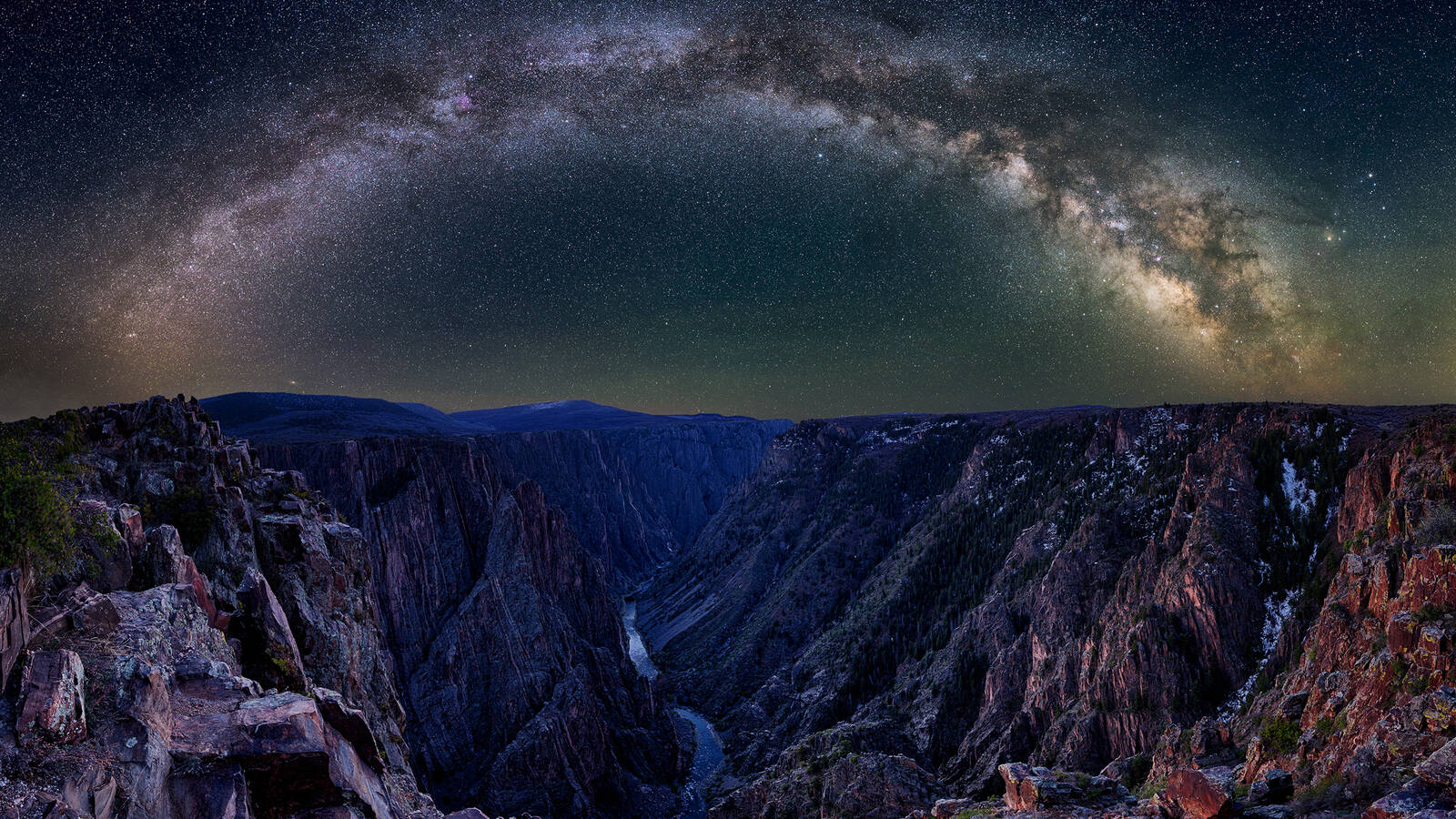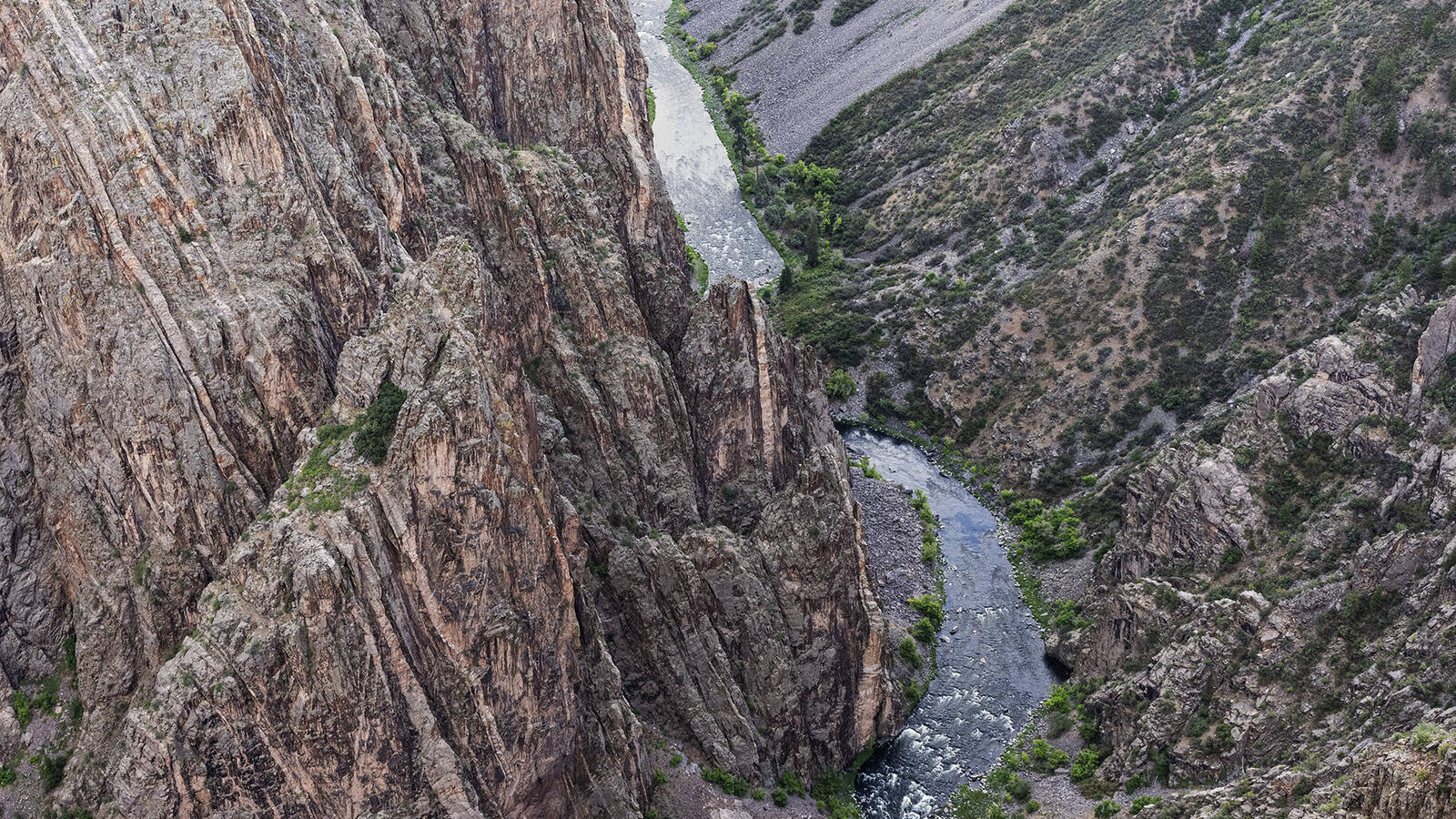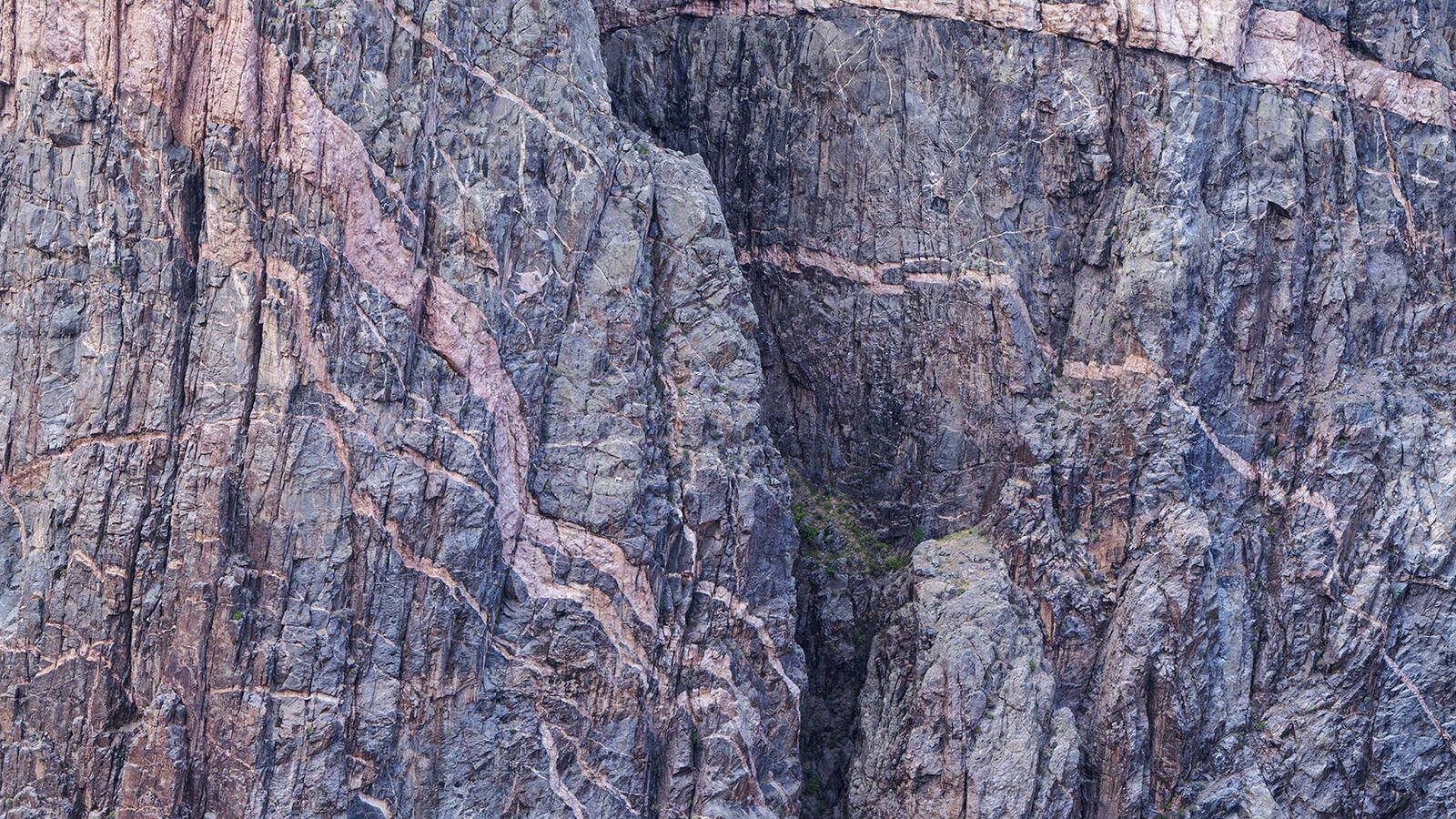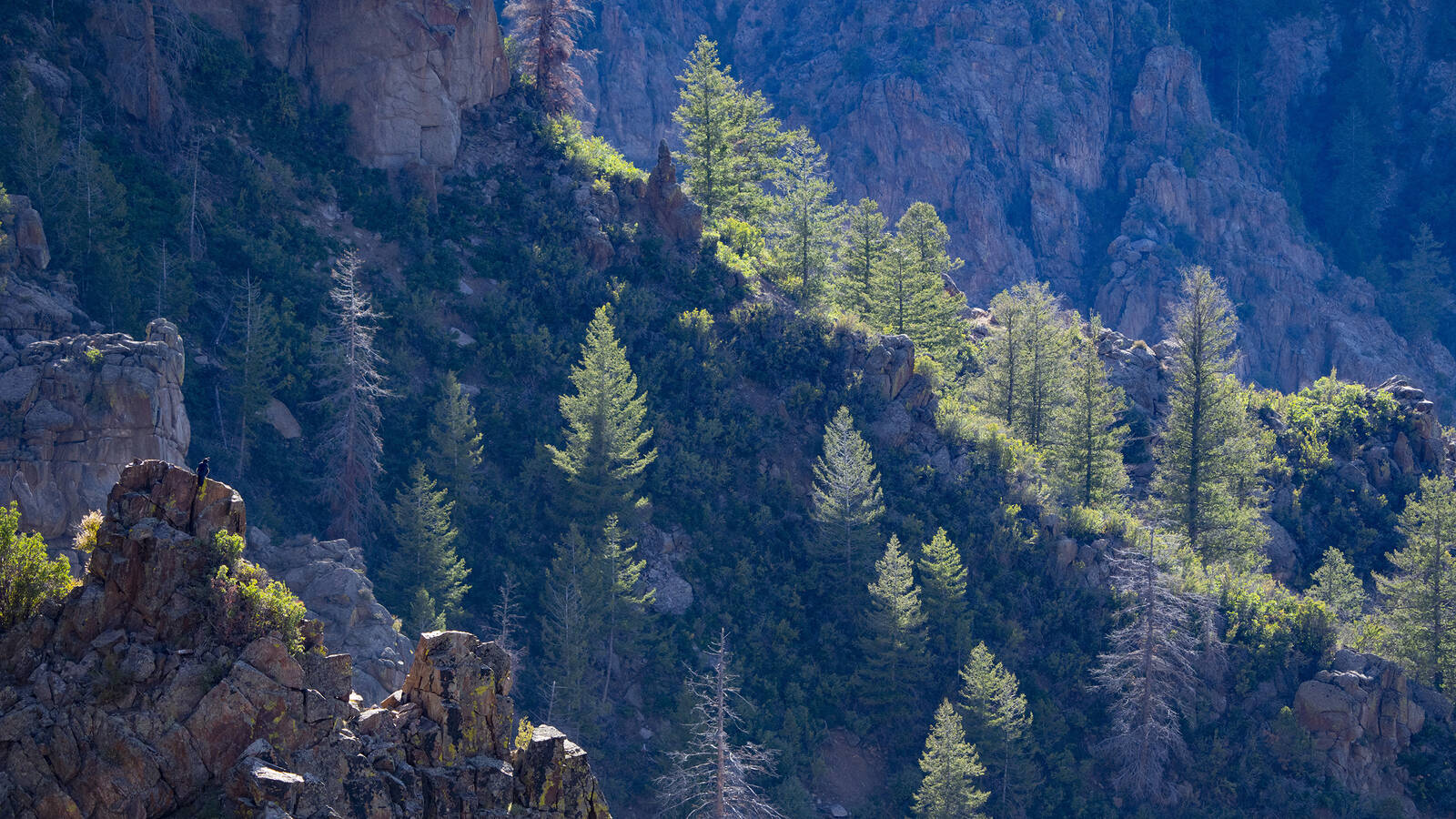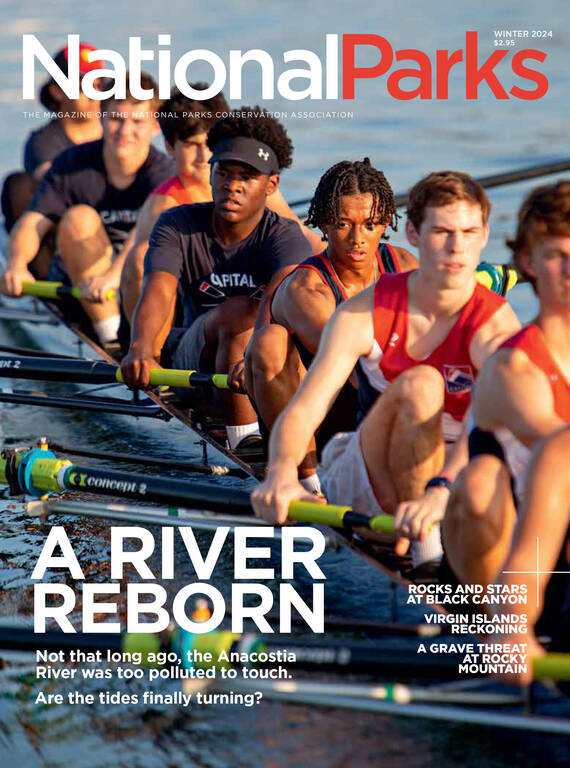Winter 2024
From Rim to River
In the Black Canyon of the Gunnison, night skies and astounding geology enchant visitors.
I awoke in blackness, summoned from sleep by my phone’s beeping alarm. A moment of confusion — a sleeping bag against my body rather than sheets, a thin pad beneath me instead of a mattress. Then it came back to me: Right, yes, we were lying in a pinyon copse wedged between rock walls in Black Canyon of the Gunnison National Park. It was 3:30 a.m. And the show was about to begin.
I unzipped the tent and, without sloughing off my sleeping bag, inched out like a massive caterpillar. I lay back on the sandy ground, still warm with the day’s radiant heat, and gazed heavenward. A broad sweep of stars wheeled above, broken by the skeletal arms of junipers. The nearby Gunnison River crashed against boulders, the white noise of erosion.
Elise, my wife, emerged from the tent and sat beside me. “Seen any yet?” she whispered.
As if on cue, a meteor blazed across the sky, its trail lingering on our retinas long after the rock itself had burnt to ash.
Full disclosure: We hadn’t known about the meteors when we planned our trip to the Black Canyon. Rather, we’d hiked into the canyon the previous day for scenery, wildlife, solitude and fishing — the same elements we usually seek in parks. Earlier that week, though, I’d read that our August trip would coincide with the peak of the Perseids, the annual meteor shower that occurs when Earth passes through the rock and dust trailing off the Swift-Tuttle comet. This was serendipitous given that Black Canyon, which cuts through a remote swath of western Colorado, is an International Dark Sky Park, an official refuge from light pollution. In other words, we’d lucked into a glorious astronomical opportunity — and if that meant setting an alarm for an ungodly hour on a Sunday morning, well, such is the price of beauty.
Black Canyon of the Gunnison is known for its dark skies. The author lucked out and happened to visit the park during the peak of the Perseids, an annual meteor shower.
©VINCE FARNSWORTH, MONTROSE, COLORADOThe canyon is 48 miles long and, in one spot, more than 2,700 feet deep. This precipitous drop gives the Black Canyon its name: Some segments of its floor receive less than an hour of daily sunlight.
©DAVE SHOWALTERFrom rim to river, the Painted Wall is 2,250 feet.
©DAVE SHOWALTERThe Pulpit Rock Overlook.
©DAVE SHOWALTERThe ridgeline at Sunset View.
©DAVE SHOWALTER
Over the next 45 minutes, dozens of meteors burned across the sky. Some fell as brief, white-hot bursts of phosphorescence, others as long, gentle arcs, like canyon-spanning tightropes. Eventually the spectacle slowed, and Elise returned to the tent, but I stayed out a while longer, watching the last few ancient chunks of comet rain down upon our atmosphere, feeling grateful for the dark.
Although Black Canyon of the Gunnison is rightly celebrated for its skies, geology is the true star. Some 15 million years ago — an epoch when rhinoceroses and elephants still roamed North America — the Gunnison River poured into a valley between two lines of volcanoes and began to chew through nearly 2 billion years of accumulated rock. The river, fueled by snowmelt and laden with grit, sliced through even the hardest layers at a rate of about an inch per century. The deeper it carved, the more concentrated and powerful it became, eventually attaining 2.75 million horsepower. The result of this relentless blasting: a canyon 48 miles long and, in one spot, more than 2,700 feet deep — deeper, in fact, than it is wide. It’s these precipitous dimensions that give the Black Canyon its name: Its walls are bathed in shadow, and some segments of its floor receive less than an hour of daily sunlight.
The Black Canyon’s legendary sheerness makes it a forbidding place. The Utes, Native inhabitants in the region, lived along its rim but seldom descended into its depths. John Williams Gunnison, the U.S. Army captain who visited in 1853, deemed the canyon the “the roughest, most hilly and most cut up” country he’d ever seen. Not until 1901 did a pair of explorers fully navigate the canyon’s roaring, boulder-strewn bottom — both on foot and, incredibly, an inflatable rubber air mattress.
Horace Albright, the National Park Service’s future director, stuck to admiring the chasm from above in 1917. “By God, it’d make a magnificent national monument or even a national park,” Albright declared. Although Albright’s prophecy was partially fulfilled in 1933 when the canyon was named a monument, it would take more than six additional decades for Congress to redesignate it a national park. “It’s a burden being taken off,” Ben Nighthorse Campbell, the U.S. senator and Northern Cheyenne Tribe chief who pushed for the park, declared when 14 miles of the Black Canyon finally attained park status in 1999. “You’re just sort of euphoric.”
Perhaps because Black Canyon is among America’s newer national parks — and, at less than 31,000 acres, one of the smallest — it’s not jammed with tourists. Fewer than 300,000 people swung through in 2022, placing it near the bottom of the 63 national parks in visitorship. Like John Gunnison and Horace Albright before them, most of these gawkers merely peer down from the rim. Only expert kayakers can paddle the canyon’s Class V rapids, and the Park Service deems rafting “not possible.” With a wilderness permit, however, you can hike to the inner canyon, the park’s deep, dark floor, via one of the half-dozen established routes that switchback down near-vertical flanks. Elise and I would do old Horace one better, we decided: We were going in.
A month before our trip, Elise nabbed us an online reservation for Red Rock Canyon, where the Park Service allows only four groups per day. It was an appealing option. The Red Rock section of the canyon floor, on the park’s western edge, is wider and shallower than the inner canyon proper, and the access trail, which descends 1,300 vertical feet in 3.5 miles, isn’t particularly steep or treacherous. Red Rock thus offered a chance to experience the beauty and serenity of the Black Canyon’s interior — all without braving trails better suited to bighorn sheep.
The tiny trailhead parking lot, when we arrived on the appointed afternoon, held just one other car — almost inconceivable in an era when national park visitors get into literal fistfights over parking spaces. We donned our backpacks and followed a dirt two-track through pasture specked with desiccated cow patties. Prairie dogs popped from their burrows to chuckle their alarms; an eastern collared lizard posed for photos, emerald flanks glittering. We were grateful for the cloud cover that made our walk through this stark landscape pleasant. Piece of cake.

See a Sky Full of Stars at These Certified Dark-Sky Parks
Lay out a blanket after the sun goes down and see a clearer view of the galaxy at these designated dark-sky parks.
See more ›Well, no. After a mile, the road passed through a gate, entered tall grass and dwindled to a proper trail along a shallow creek. The trail stuck to the bank for a few minutes, then vanished in thickets of Gambel oak. We thrashed through grass and water, thoroughly soaking ourselves, before finally locating the trail again, a crumbly goat path cut into a sandstone wall. Then the trail descended back into the creek and faded to a line of matted grass on the other side. If national parks are America’s best idea, the Red Rock Canyon trail seemed to be America’s vaguest notion.
That impression was repeatedly confirmed over the next three hours. The trail clambered over boulder fields, blundered through oak tunnels and twined with the stream in multiple places. We lost it, found it, lost it; we played Marco Polo as we crashed through pinyon stands; we skidded down muddy waterfalls. (Yes, at one point, the trail was a waterfall.)
“You look like you got in a fight with a cat,” Elise said as I emerged, bleeding, from a tangle of sumac. “Like maybe a mountain lion.”
However disgruntled I may sound, I promise this is not a litany of complaints — not every trail needs to be the boardwalk around Old Faithful — but rather a descriptive account that may help future adventurers make their own informed decisions. To that end: Did I mention the poison ivy? So much poison ivy. We high-stepped over it and twisted around it like art thieves in a heist movie. “We should’ve brought a machete,” Elise half-joked.
As the afternoon wore on, our morale flagged, and might have collapsed altogether were it not for the scenery. Sandstone spires sprouted overhead as the canyon narrowed, and sparkling metamorphic veins shot through tilted walls. Finally, we entered the Black Canyon and beheld the Gunnison River, a foamy, greenish torrent sliding along rose-tinted cliffs. We dumped our backpacks in a juniper grove alongside a glassy pool, an inviting pause in the river’s breakneck course. Then we stripped off our clothes, eased our sweaty bodies into the Gunnison’s invigorating chill, and washed our cares and poison ivy away.

Rock On: 11 Lesser-Known Geologic Wonders in National Parks
From mysterious gliding rocks in Death Valley to fossils of some of the most ancient life forms in Glacier, here are 11 lesser-known geologic wonders—including a few personal favorites from…
See more ›And what of the river itself? The Gunnison River originates in the Rocky Mountains and rolls 180 miles west before pouring into the Colorado River at the city of Grand Junction. Like most Western rivers, the “Gunny” is hardworking, diverted by tunnels and canals to irrigate hundreds of thousands of acres of farms and ranches. The 2.5-hour drive to the Black Canyon from our home in central Colorado had followed the Gunnison’s course past several dams, including the dramatic Blue Mesa, which widened the slender river into a shimmering 9,000-acre reservoir — one of the largest bodies of water in the state of Colorado.
Although the dams lie above the Black Canyon, they have nevertheless transformed the park’s ecosystem. For one, the cold, clear flows that spill from the dams have created superb trout fishing conditions. Today the Gunny is a certified Gold Medal fishery, meaning, basically, that it produces lots of big trout. Granted, these fish are nonnative brown and rainbow trout historically stocked for anglers, rather than the distinct lineage of cutthroat trout that once inhabited these waters. As an avid fisherman with a strong preference for free-flowing rivers and native trout, I have decidedly mixed feelings about these developments. But I’m powerless to resist the allure of wild trout, no matter their provenance, and no sooner had we made camp than I was marching down to the river, fly rod in hand.
Decision time: What fly to present my quarry? As I approached the white-flecked Gunny, a soft rain of grasshoppers pattered against chest-high grass. Easy enough, then. I tied on a hopper imitation, clambered onto a rock and cast into an eddy. The grasshopper vanished in a swirl of foam, and I quickly captured and released a lovely brown trout bedecked in crimson and obsidian spots: my first Gunnison River fish.
This was an auspicious start, but it wasn’t browns I sought. Rainbow trout make up around 20% of the canyon’s fish population, some true lunkers among them. And the fish have a compelling backstory: In the mid-1990s, the Gunnison River’s young rainbow trout began to die of whirling disease, a parasite-caused malady whose victims spin madly until they perish. The disease hit other rivers, too, and soon Colorado’s wild rainbows had virtually vanished. But in 2012, state biologists found a cluster of rainbow trout in the Black Canyon’s East Portal section that had evolved resistance to whirling disease. The scientists collected eggs, bred the fish in a hatchery, and poured them back into the Gunnison and other rivers. Today the park’s population is thriving, although anglers still have to release all rainbows. (Hungry fishermen can harvest four brown trout per day.) Perhaps this sort of thing only excites fish nerds like me, but the Black Canyon is a landmark location in the annals of Colorado fisheries science, and I longed to hook one of these fascinating chimerical rainbows, amalgams of natural selection and human technology.
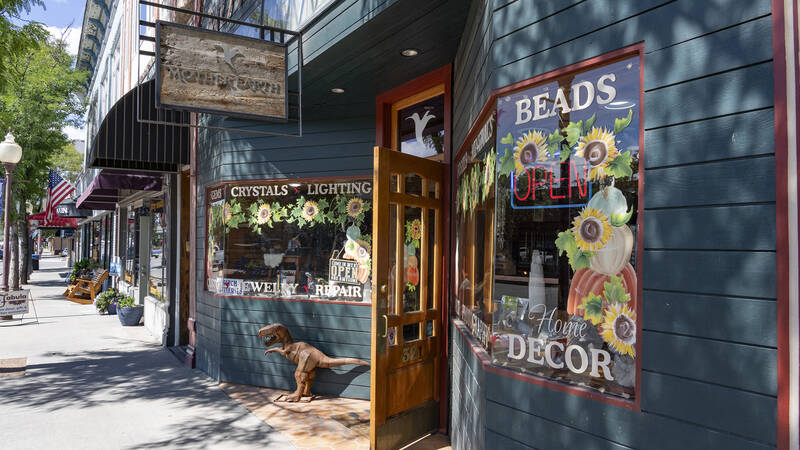
Montrose, Colorado, is the closest gateway town.
©DAVE SHOWALTERFor a time, it seemed I wouldn’t have the chance: After my first trout, the river turned quiet. Happily, though, as dusk descended, a blizzard of mothlike caddisflies materialized on the water, and soon the trout were leaping like porpoises. I landed three browns in short order, including an 18-incher with the robust proportions of a nuclear submarine.
Preparing to cast again, I glanced toward a riffle and spotted a tantalizing flash of dark purple: the glinting back of a rainbow trout. I flicked my line toward it, the fish rolled and the fly vanished. The rainbow wheeled downstream, stripping 30 feet of line off my buzzing reel in an instant, as though I’d hooked a powerboat. Once in deep water, the trout refused to budge, and the rod shivered with every shake of its massive head. Finally, it spit the fly and the line went slack. As it turned out, no rainbow would touch my net on this trip, but I wasn’t disappointed. Instead, I felt fortunate to have interacted with so powerful a creature, however brief our connection.
The next morning, after a riverside pancake breakfast, we hiked out of the canyon. The blessed cloud cover had vanished, and of course now we were going up, but our new familiarity with the trail kept us on track, and we made good time. The only snafu occurred when I took off my shoes to ford the stream and brushed a cactus with my left pinkie toe, injecting it with dozens of near-microscopic spines like shards of fiberglass. … But let us not speak of such things.
ABOUT THE PHOTOGRAPHER
Having spent time within the canyon, we decided next to experience it from above. After reuniting with our car at the trailhead, we drove past the main entrance — gaining many hundreds of feet of elevation as we climbed toward the rim — and along the 7-mile-long main park road, which parallels the sinuous south edge. (Roads follow both the north and south rims, but the south is far more trafficked, owing to ease of access.) The road dead-ended at Warner Point, where we parked and hiked three-quarters of a mile past centuries-old pinyons, artfully sculpted into bonsai by time and the elements. Wind hissed over the Colorado Plateau, and golden eagles rode thermals on silent wings.
The ridge proved the perfect vantage from which to admire western Colorado’s geography. To the south sprawled the green hayfields of Montrose, the park’s gateway town, vivid proof of the many straws that sip from the Gunnison. Beyond the farms rose the jagged volcanic lip of the San Juan Range, still dotted with snowfields. To the north, the neat isosceles triangles of the West Elk Mountains; west of that, the sawed-off bulk of Grand Mesa, the world’s largest flat-topped mountain. Below us yawned the canyon itself, an infinite pastel spectrum of rose, purple, beige and maroon. It seemed incomprehensible that the faint indigo thread of the Gunnison carved this abyss.

National Parks
You can read this and other stories about history, nature, culture, art, conservation, travel, science and more in National Parks magazine. Your tax-deductible membership donation of $25 or more entitles…
See more ›After pitching our tent at the South Rim Campground that evening, we embarked on a tour of the rim’s many overlooks. We paid visits to Pulpit Rock, a promontory that juts so far into the canyon that it seems you could step off and plunge straight into the Gunnison; Painted Wall, a vertiginous rock face etched with pink pegmatite as though scrawled with alien runes; and Tomichi Point, which we redubbed Grouse Terrace in honor of a female dusky grouse basking atop parked cars. Then it was on to Sunset View to watch our fiery orange orb descend through lilac clouds and turn the Gunny to molten bronze. At the Grand Canyon such a spectacular display would have been a mob scene, but here only a couple dozen tourists had congregated. A septuagenarian serenaded his friends on acoustic guitar. The sky faded, and we dispersed.
Six hours later, I again woke in the dark to stroll our campground loop and watch the Perseids. The meteor shower was less spectacular than it had been during our night by the river, but the Milky Way was more majestic here on the plateau, its pale brushstrokes unobstructed by canyon walls. I heard tent zippers buzz and an RV door snap shut, and realized, with a pleasurable sense of solidarity, that I was enacting this nocturnal ritual with a few other park-goers — a small community of sky-watchers gathered in the dark.
About the author
-
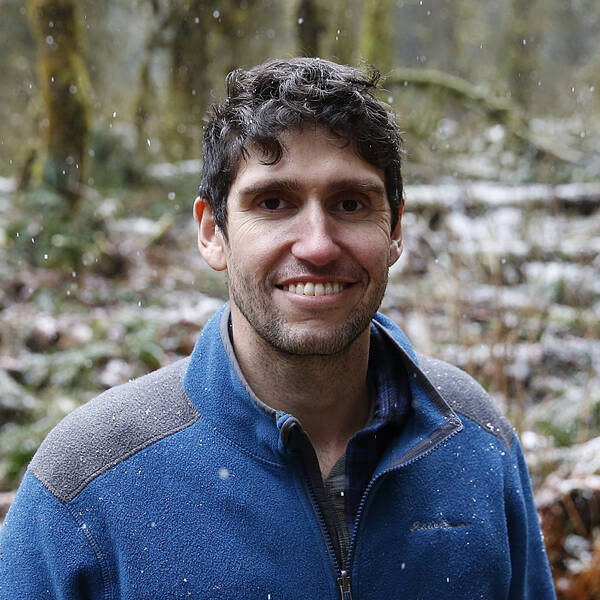 Ben Goldfarb Author
Ben Goldfarb AuthorBen Goldfarb is the author of "Crossings: How Road Ecology is Shaping the Future of Our Planet" and “Eager: The Surprising, Secret Life of Beavers and Why They Matter.”
